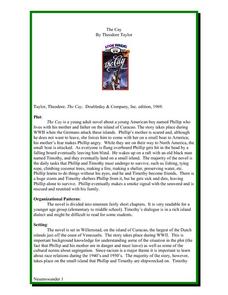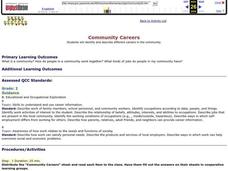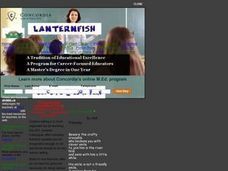Novelinks
The Cay: Concept Analysis
This overview of Theodore Taylor's The Cay is designed as an introduction for teachers who are considering using Theodore Taylor's novel for whole-class and/or book circle study.
Maryland Department of Education
The Concept of Identity Lesson 5: Motivation - Maslow's Hierarchy of Needs
Maslow's Hierarchy of Needs provides the lens class members use to analyze and evaluate the motivations of the characters in Sylvia Plath's "Initiation" and scenes from Mean Girls. Readers then select a character from A Separate...
Novelinks
The Tempest: Concept Analysis
Use a handy concept analysis guide as you begin your unit on William Shakespeare's The Tempest. With character descriptions, literary themes, and anticipated affective issues, the guide can help those new to using The Tempest craft a...
San Diego Community College
Step by Step Goal Setting
Help English learners reach their goals with a set of activities and worksheets. Over the course of three lessons, pupils define what a goal is and set their own academic and attendance goals for class.
Star Wars in the Classroom
Star Wars Geography Unit
What kind of animals live on an ice planet like Hoth? How would the habitat on Tatooine allow different organisms to thrive? Connect social studies, science, and Star Wars in one engaging activity that focuses on the ecosystems of the...
Mathed Up!
Scatter Graphs
Make an estimate by getting in line. The class works with scatter plots and lines of best fit to make an estimate for given values. Pupils determine whether there is a positive or negative correlation and draw a best-fit line. Using the...
Mathed Up!
Angles: Parallel Lines
Viewers are presented with seven problems with parallel lines and angle relationships and must use the given information to find the measures of specific angles. To finish, they explain their process in finding the measures in the problems.
Mathed Up!
Symmetry
Eleven problems provide pupils the opportunity to find the lines of symmetry or identify rotational symmetry. Scholars alter designs to make them symmetrical, learn to recognize signs that are symmetrical, and identify the type of...
Space Awareness
History of the Universe
Your pupils may believe that you and their parents are the oldest things in the universe, but surprise! There are elements of the universe that are even older. Elementary scientists create a class timeline to demonstrate the expansive...
NASA
Ripening of Fruits and Vegetables
How long do fresh foods last in space at the International Space Station? Which foods perish quicker than others? How can astronauts preserve their foods to make them last longer in space? Young scientists test the rates at which some...
Facebook
Respect and Boundaries
Respect is a must-have in healthy relationships! Pupils explore their boundaries and identify the elements of respect during a lesson from a library of digital citizenship activities. The teacher's resource section contains a printable...
Biology Junction
World of Insects: Characteristics, Orders, and Collecting
Every bug is an insect, but not all insects are bugs. A presentation lists the characteristics of insects, describes their body parts, and explains metamorphosis. It also details every order and includes photographs and multiple facts...
National Woman's History Museum
The Equal Rights Amendment
The debate over the Equal Rights Amendment continues. To better understand the controversy, class members research the history of attempts to get the amendment ratified. In addition, pairs engage in a structured academic conversation...
American Museum of Natural History
Saving Species
Some scientists dedicate their lives to researching and protecting endangered species. An online lesson teaches about three scientists around the world who do just that. They learn about spiders, mollusks, and reptiles from North...
Curated OER
The 3R's: Rights, Rules, and Responsibilities
Eighth graders complete seven work stations that highlight math activities while they focus on the rules for Internet use and classroom rules for working in cooperative groups. After completing the activities, they complete a self-...
Curated OER
Science: Finlay and Yellow Fever
Ninth graders research the work of Carlos J. Finlay and his contributions to science. Once they have discussed his theories about diseases, they create tables comparing diseases that use insects as carriers. The lesson also includes a...
Curated OER
Who Controls the Real Cost of Credit Cards?
Students view the film "How Much Does Debt Cost?" and explore the reasons why credit card fees and interest rates have gone up so much over the last 25 years. They participate in class discussion and complete a worksheet.
Curated OER
Moral and Ethical Beliefs: Proverbs
Students compare and contrast the cultures of Japan and the United States. In groups, they are given a proverb from each country and note the similiarties in their teachings. They complete a worksheet and share their findings with the...
Curated OER
Designing Future Houses
Students discuss houses of the future and imagine future house designs. They create a floor plan, architectural drawing, and write a short description about their future house.
Curated OER
Conversation - Which school do we choose?
Students engage in a discussion about the reasons for learning English in order to develop their English fluency. They engage in a simulation which is imbedded in this lesson plan.
Curated OER
Island Maracas
Students listen to Caribbean folk music and discuss maracas and their role in music. They construct and design pairs of maracas using paper mache, then perform a Puerto Rican folk song using their maracas.
Curated OER
Community Careers
Second graders examine what a community is. They identify various occupations in their community, complete a handout, and discuss how people in their community work together.
Curated OER
October's Lesson Plan
Students listen to poetry about crocodiles. After discussing the relationship between humans and crocodiles, they make a list of ways humans hurt crocodiles and then write Prelutsky's poem from the crocodile perspective.
Curated OER
Hemispheres & Continents
Students learn in cooperative learning groups to determine how the equator and the Prime Meridian divide the earth into hemispheres and use Venn diagrams. Students will locate and label the hemispheres, continents, and oceans.

























